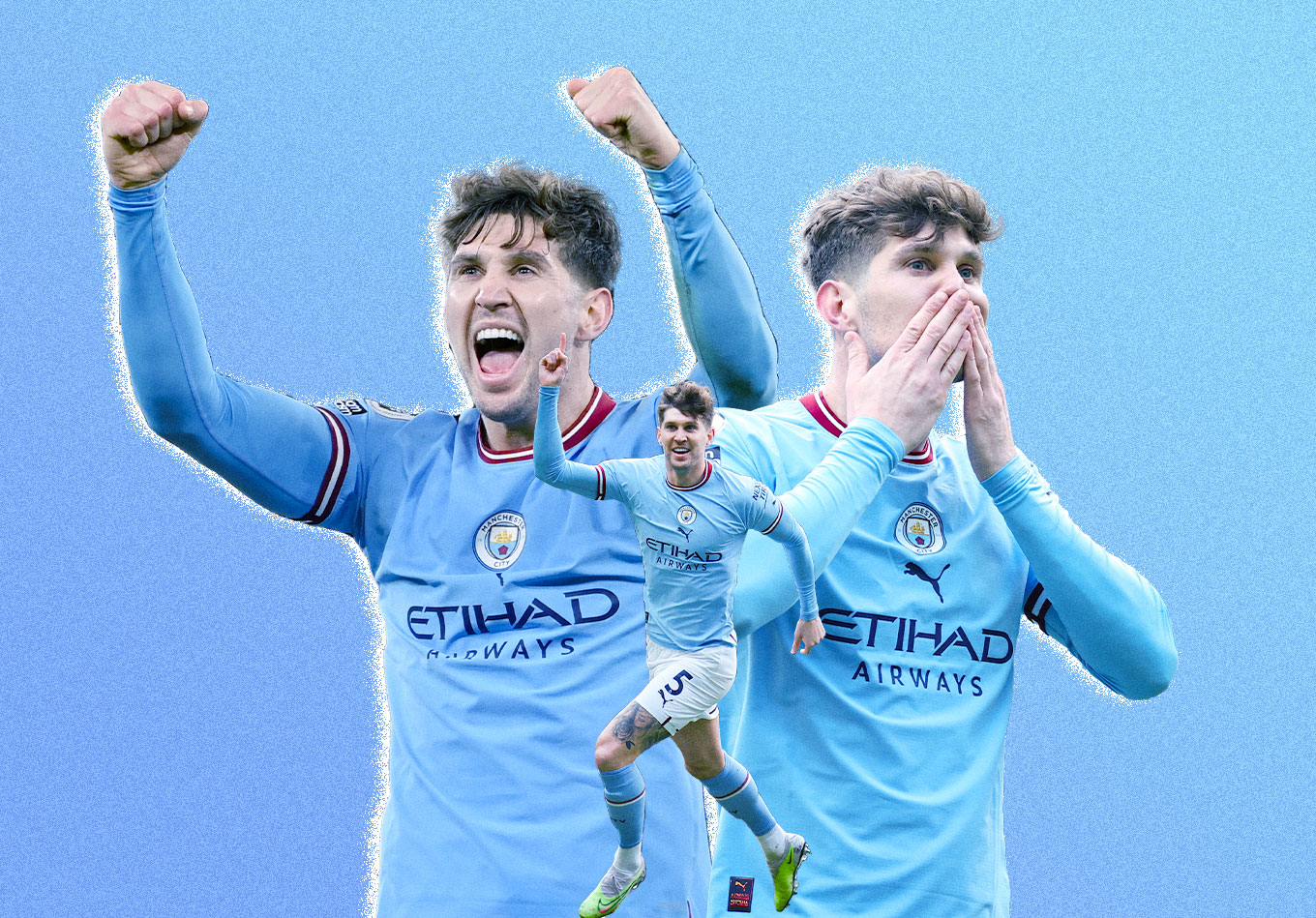We all know the routine when Pep Guardiola’s Manchester City play another big side, usually in the Champions League. Some of us open Twitter, scroll through a bunch of tweets that either say “Guardiolismo continues to break positional play paradigms” or “Fraudiola’s overthinking it again!”, before heading over to see how City’s official account lines them up. Others open their favourite football app and look at what formation the app decrees. And, inevitably, it’s never 100% correct.
In recent months, this confusion over what formation Man City are playing has seemingly increased. Some apps or media outlets line City’s players up in a good ol’ 4-3-3 while others are brave enough to list it as a 3-2-4-1, the shape that City tend to use with the ball this season.
Most of this confusion comes down to where you choose to place John Stones. Is he a part of the central defensive pairing or is he a part of the double pivot?
Of course, we know that players’ positions and roles are becoming increasingly fluid in the modern game and that teams’ formations with and without the ball are becoming increasingly distinct. We also know all about inverted full-backs who move into midfield from a nominal full-back spot.
But confusion over whether someone plays as a centre-back or a central midfielder is relatively new to us.
And this uncertainty highlights just how unique Stones’ new role is at Manchester City. When City have the ball in and around their box, Stones is in a central defensive pairing…
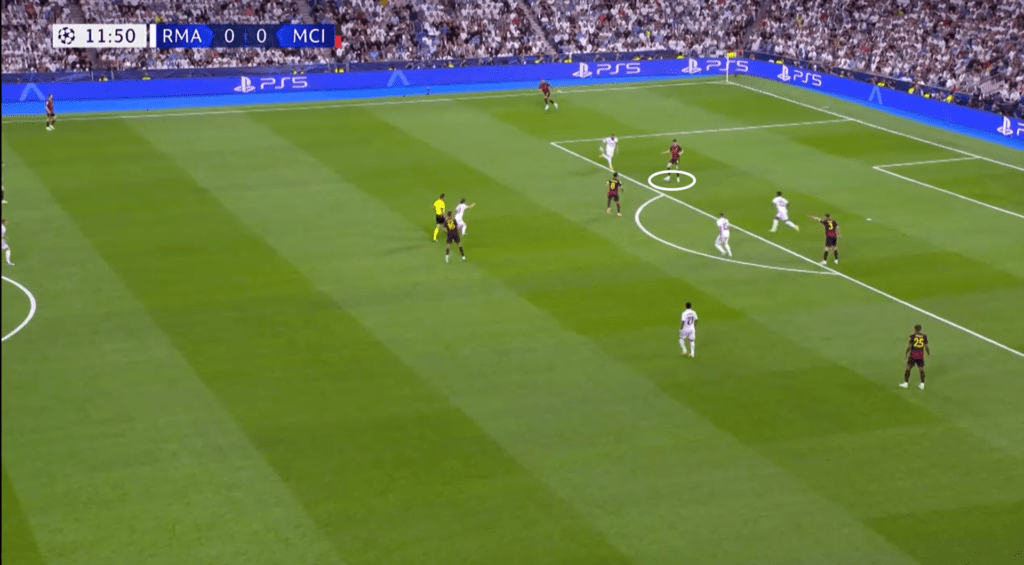
…but when City move up the pitch, so does Stones, unmistakably a part of their midfield box and often venturing into the attacking third.
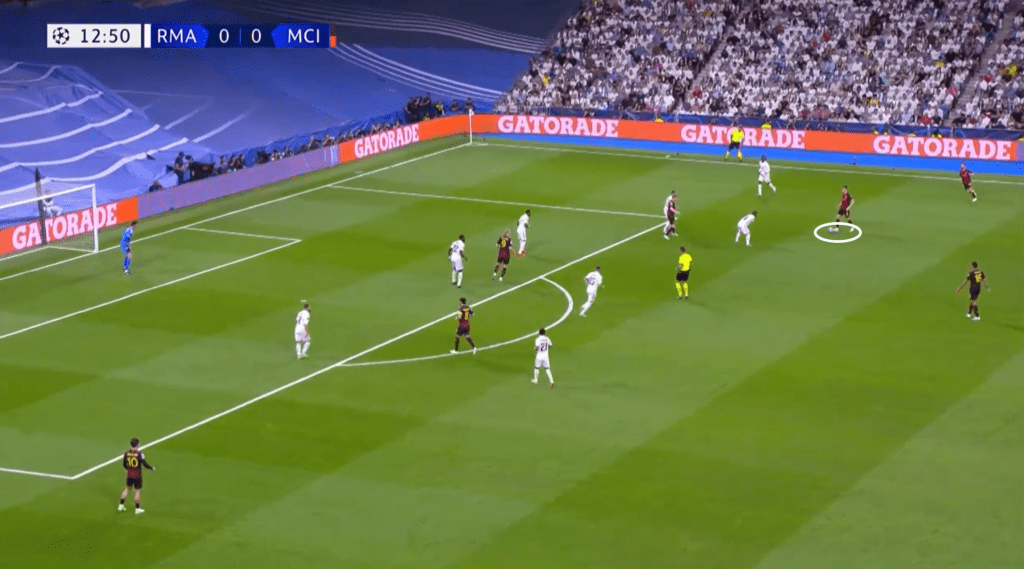
On the other hand, when City don’t have the ball, Stones’ positioning is far more conventional, as a central defender in a shape that’s generally 4-4-2.
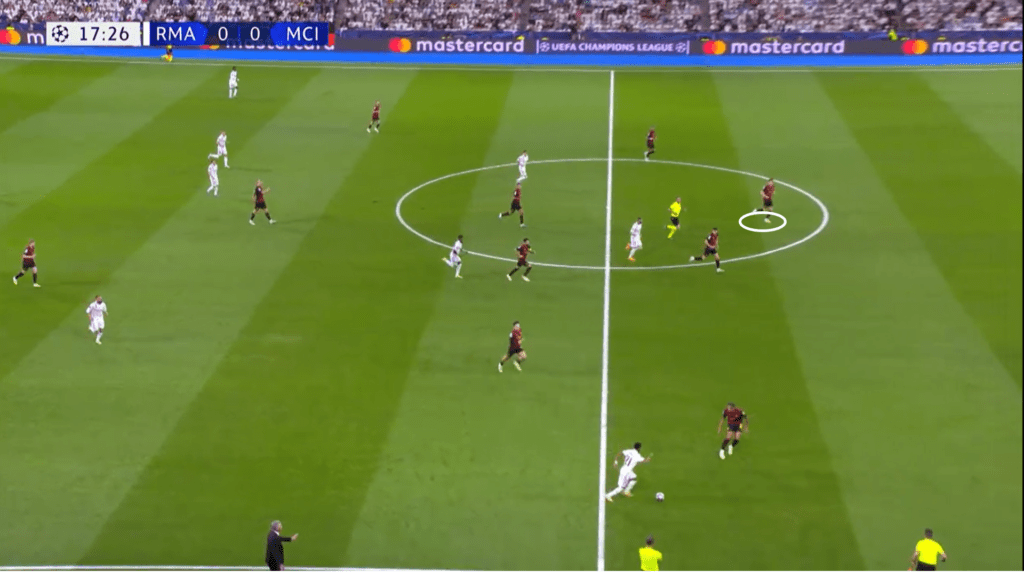
This begs the question: why? Why this dual role? Why use a central defender to move into midfield (or use a central midfielder to retreat, whatever way you see it) instead of using an inverted full-back?
Exploring Stones’ role opens a window into understanding the way Guardiola’s Manchester City have adapted over the past season and how these changes have brought them to the cusp of a treble.
But first, let’s take a look at precursors to this hybrid role to examine the genealogy of how Guardiola is using Stones.
Precedents
Of course, while Stones’ role may be unique in today’s tactical environment, it isn’t a sudden phenomenon that’s come from nowhere.
A notable recent example – albeit in a different context, turning a back three out of possession into a back four in possession – is Andreas Christensen’s centre-back-plus-defensive-midfielder role for Denmark in Euro 2020, turning Denmark’s 3-4-3 into a 4-3-3. As Om Arvind writes, Christensen stepping up into midfield helped nullify any opposition’s numerical advantages in the middle while also enabling the double pivot in front of him to push up and become de facto number eights. This gave the team an added level of flexibility both in and out of possession.
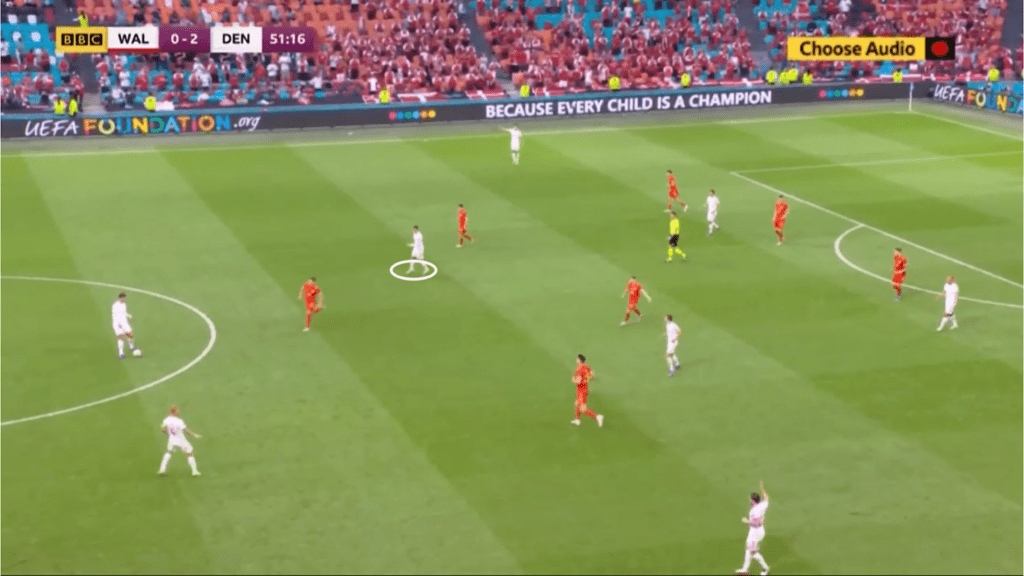
But we can find a more relevant example to which we can trace Stones’ current role. It comes from the final year of Guardiola’s Barcelona spell, his Yeezus season, 2011-12. As Rene Maric and Michael Cox each noted, for most of their derby game against Real Madrid away, Barcelona played something akin to a 3-4-3 diamond shape (with Lionel Messi as the 10 and Alexis Sánchez up front) that turned into a 4-4-2 without the ball as Sergio Busquets dropped into the left-centre-back spot.
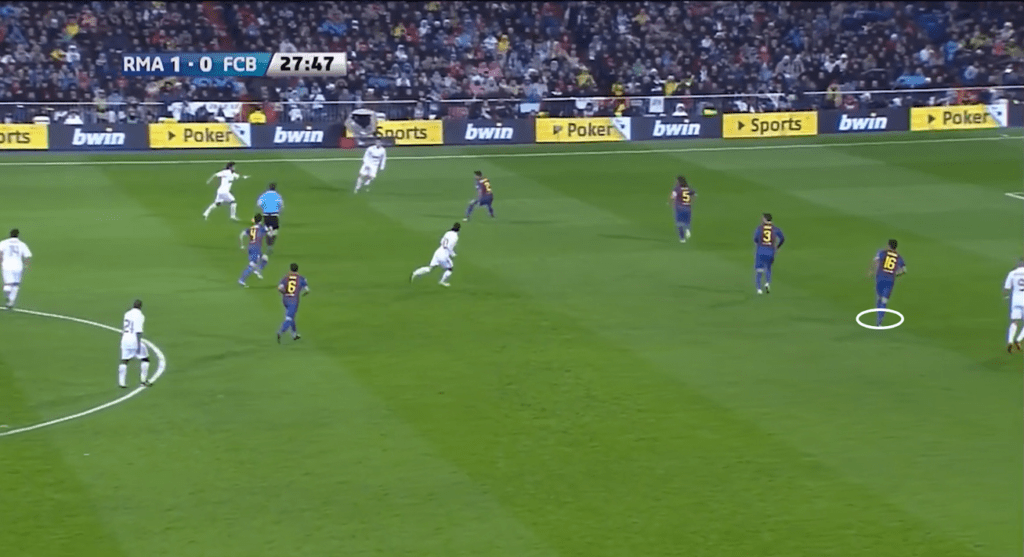
But why? As Cox writes, starting in a back four shielded Busquets from Real Madrid number 10 Mesut Özil’s pressing and marking in the early stages of the build-up, and pushing him up into midfield gave Barça an extra player in the middle of the pitch, allowing Xavi to push forward when Özil pressed Busquets. Plus, intuitively, having an extra auxiliary centre-back certainly helped quieten the counter-attacking threat of José Mourinho’s Real Madrid. It’s worth noting that a key difference from Stones’ role today is that Busquets seemingly played a more aggressive, front-foot defensive role in the backline compared to Stones, often jumping up a line to pressure the player with the ball.
Today, the same fundamental advantages apply to Stones’s role in City’s setup, but with a couple of nuances that come with the way the game’s changed in the decade since Guardiola’s Barça.
Midfield Boxes, Man-Marking, and the Extra Man
As Jon Mackenzie describes in his video for Tifo IRL, one trend at the highest level of football this season is that several high-possession elite sides are increasingly converging towards using four players in midfield, arriving to a vaguely 3-2-4-1 shape with the ball in different ways, usually from a base 4-3-3 formation.
The advantage of having four in the middle boils down to the simple fact that you outnumber your opposition in midfield, with man-marking-based pressing systems having to adjust in a way that twists their defensive shape and creates spaces for other attackers to exploit.
What makes Guardiola’s City – unsurprisingly, at the vanguard of this box midfield wave – different, especially of late, is the way that they arrive at this shape.
Most teams tend to arrive at a 3-2-4-1 shape by moving a full-back inside (like Oleksandr Zinchenko at Arsenal) or by moving a full-back high up the pitch (like Alejandro Balde at Barcelona). However, since the departure of João Cancelo to Bayern Munich, and after a spell of using Rico Lewis as an inverted full-back in possession, which worked pretty well in fairness, Guardiola seems committed to lining up with four nominal centre-backs, with Stones playing in the double pivot for most of the game.
If inverted full-backs were hard enough to mark, splitting marking responsibilities between opposition wingers and attacking midfielders, a marauding centre-back is even harder to mark, especially as more elite teams move towards man-marking in midfield. A player who starts at the centre of the backline isn’t usually followed across the pitch, and this helps give City an extra player in every phase of possession.
To demonstrate, we can look at how easily Stones got on the ball and moved it into dangerous areas in City’s first leg against Real Madrid.
Madrid went man-to-man across most of the pitch, with two centre-backs on Erling Haaland, both full-backs marking the wingers, wingers tracking the wide centre-backs, and the midfield occupying City’s nominal midfield trio of Rodri, Ilkay Gündoğan, and Kevin de Bruyne. Stones usually found himself in space, easily getting past Karim Benzema’s rudimentary covering.
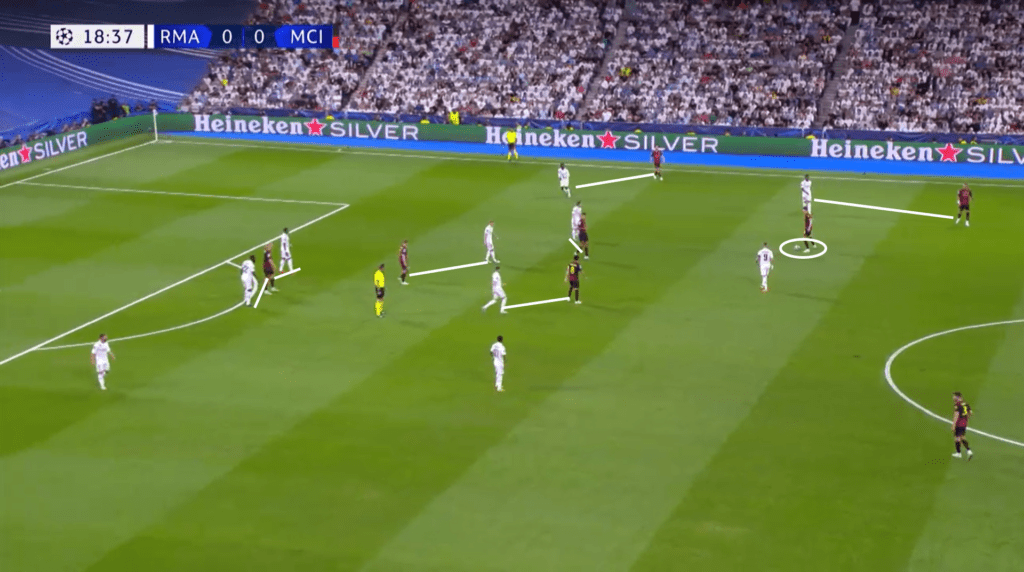
When Stones got on the ball, this usually unsettled Madrid’s marking duties, with a midfielder jumping to press Stones, leaving another City midfielder free.
In the below example, Luka Modrić jumps to press Stones, which opens up a one-two with Rodri, which enables Stones to carry the ball into the box.
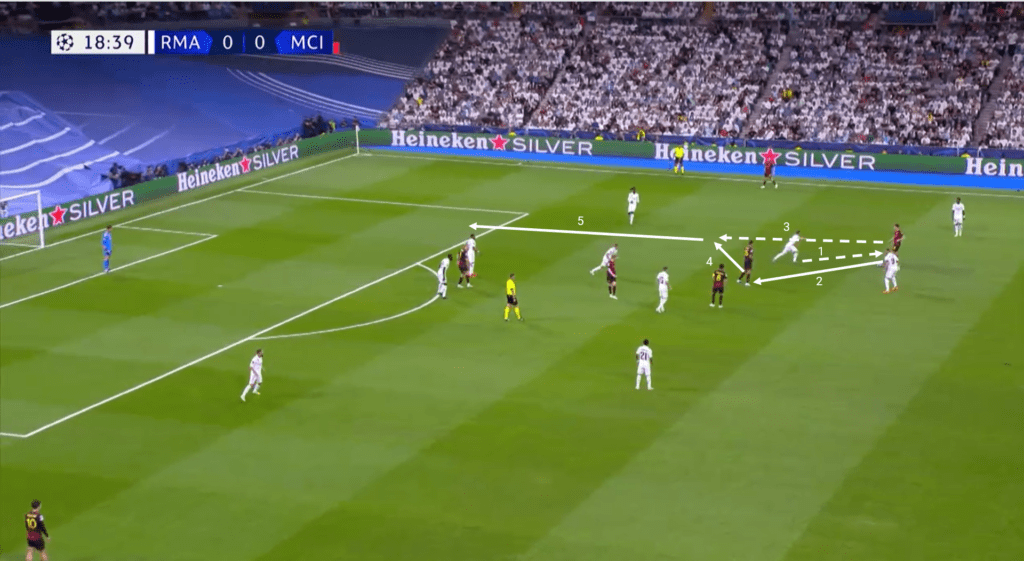
In addition to what Stones does with the ball in space, a key advantage of him being a member of the midfield box is simply down to what he allows his midfield partners to do. When he ventures forward, he occupies an opposition midfielder and creates space for one of his teammates to drop into.
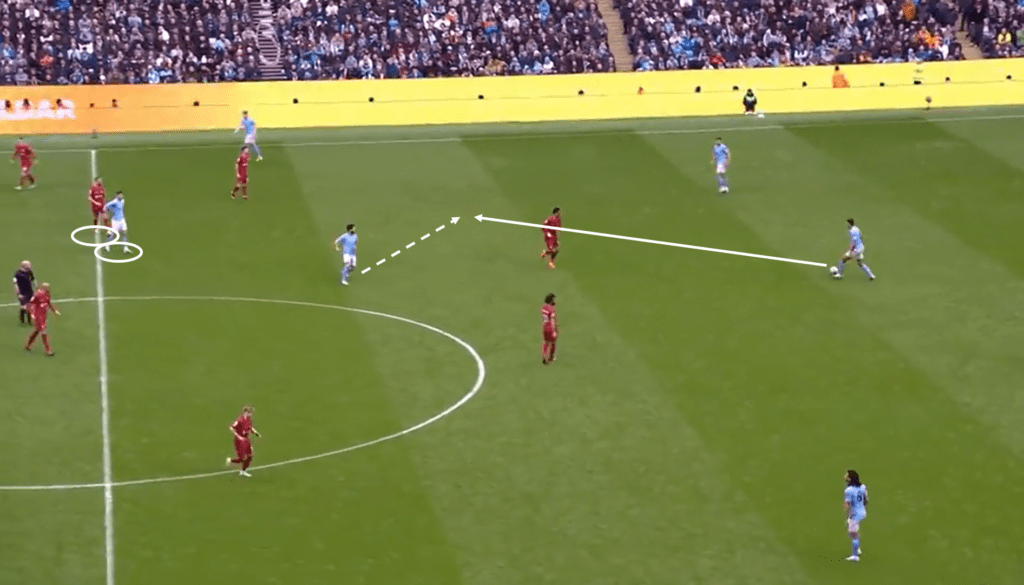
Stones’ security with and without the ball at the base of the midfield helps free up Manchester City’s advanced midfielders more, with De Bruyne and Gündoğan playing freer, more advanced roles than ever.
But of course, while Stones may just be better with the ball at his feet, it looks like there’s another reason to use him as a centre-back-plus-midfielder versus using Rico Lewis as an inverted full-back. And that’s because Stones’ role provides even more security when City lose the ball…
Defending the Counter-Attack
Guardiola’s sides have always attempted to play expansive, possession-based football with numbers up front while also placing a heavy emphasis on preventing counter-attacks when they do lose the ball.
But this season, Manchester City are a slightly different team.
With the signing of Erling Haaland, City use a conventional striker up front again, and while City now play with the most prolific goalscorer in the world, their style of play has had to slightly adapt to Haaland’s profile. Having a striker who specialises in running in behind adds an emphasis on playing riskier passes in behind the opposition in the final third, which naturally means that City have more turnovers to prepare for. This calls for an even greater focus on passing the ball around with a shape that helps defend counter-attacks better.
The basic logic of using inverted full-backs is that it helps prevent the opposition’s threat on the counter. When your full-backs are deeper and narrower than conventional overlapping full-backs, it’s easier for them to retreat to defend the counter-attack when you lose the ball. When they start closer to the central areas of the pitch, they’re guaranteed to be closer to the most crucial areas of the pitch to defend as soon as the ball is lost. As a result, inverted full-backs have been a constant feature of Guardiola’s sides, especially since his Bayern Munich days.
Right now, however, when he needs it even more, Guardiola may have an even more effective way to prevent counter-attacks. As exotic as pushing a centre-back into midfield sounds, Stones starts with three other centre-backs beside or behind him. At the moment that City lose the ball, they have three centre-backs and at least one of Stones and Rodri behind the ball and ready to snuff out any potential counter-attack.
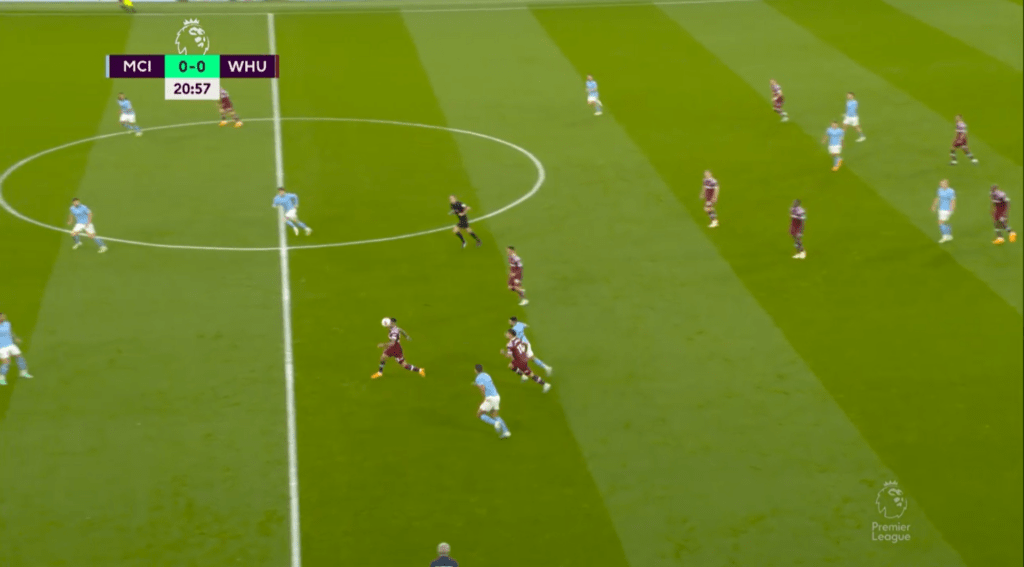
Plus, when City lose the ball, Stones immediately sprints to retreat and join the backline as a central defender. While he may only be a moderately-fast runner, his starting position, deep and central, ensures that he ends up getting back in time to form a four-centre-back backline and comprehensively stop a counter-attack.
This answers another question: why use Stones as a hybrid centre-back-midfielder instead of using him as an inverted right-back as Guardiola has in the past?
It’s simply just easier for City to segue from a 3-2-4-1 to a 4-4-2 and vice versa when they lose and win the ball with Stones making shorter vertical movements back and forth. The diagonal retreat and advance back and forth between the double pivot to the full-back spot involves covering more ground, and City have faster defenders who can make up ground in the wide areas better. The speed and physicality of Manuel Akanji and Nathan Aké makes them better suited to being fielded as wide centre-backs – deep, narrow full-backs out of possession – while Stones stays in the centre.
So, does it work? Well, as Jon Mackenzie notes in his video on the subject, City have conceded fewer direct attacks since they started using Stones in his new role, going from 1.2 to 0.6 per game. Direct attacks are essentially proxies for counter-attacks: they measure the number of sequences that start just inside a team’s defensive half that have at least 50% of movement towards the opposition’s goal and end in a shot or a touch in the opposition box. City are conceding fewer of those than ever before.
Similarly, this season, City have slowed down the pace of their opposition’s attacks. Teams progressed the ball upfield against City at 1.47 metres/second last season (10th best in the league). That’s dropped to a sluggish 1.18 m/s this season (the slowest rate in the league).
City are also far better at preventing the opposition moving up the pitch from a pure distance perspective, too. In 2021-22, teams averaged 10.9 metres of progression per possession sequence (the third-lowest in the league) and that’s fallen to 9.8 metres on average this season (the lowest in the league).
All in all, watching Stones in his new role at City seems to reveal a bunch of simple, mundane benefits of the role rather than an upheaval that ushers in a new paradigm of possession football. But that in itself is significant.
The first time that Stones started in this role, Manchester City beat RB Leipzig 7-0 in the Champions League’s round of 16. The average number of goals City have scored in a game this season since the switch has gone up to 3.2 from a previous 2.3 per game. Considering how vanguard a centre-back who moves into midfield sounds, you’d be forgiven for thinking that this role is a swashbuckling attacking invention.
But there’s another change in the simple stats that maybe helps us understand the value of Stones’ role better. Ever since the change in role, City have conceded just 0.5 goals per game down from 0.9, a decrease of 41%. While we can’t attribute all improvement to one factor changing, Stones’ new role has accompanied a noticeable tightening of City’s defence while the attack also continues to flourish.
Apart from how exotic a centre-back in midfield sounds, Stones’ new role seems to be a practical solution to City’s squad changing with the departure of Zinchenko and Cancelo, who were staples of the side as inverted full-backs.
Compared to using Lewis or even Bernardo Silva as an inverted full-back, playing Stones in this role is more conservative, and allows City to field an extra central defender without the ball who can defend the channels better.
And as Guardiola himself mentioned after City’s title victory against Chelsea, having extra centre-backs on the pitch better prepares his team to win individual duels. Only Aké (67.5%) has a better overall duel success rate than Stones (67.3%) in a City shirt this season.
And that’s what it boils down to: playing Stones as a centre-back-plus-midfielder ensures that City have an extra player in midfield in attack and an extra centre-back in the early build-up and in defence.
We hear the phrase ‘numerical superiority’ each time Guardiola’s tactical approach is discussed, and Stones’ role is a pragmatic next step that gives City an extra player in more situations, allowing them to attack in numbers while having less to worry about when they lose the ball.
So, all that leaves us with one final question: what the heck do we call this role?
Enjoy this? Subscribe to our mailing list to receive exclusive weekly content. And follow us on Twitter.
